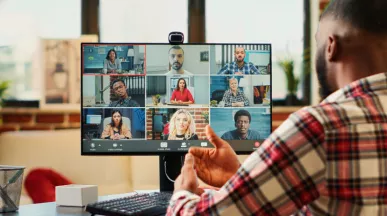3 Employee Engagement Strategies Connect Remote Global Teams

By Kelly Briggs
Our global economy and workforce are more interlocked than ever before and since technology enables us to work from anywhere, it’s not uncommon to communicate with teams that are dispersed across the globe. As more of us are working remotely, it’s a challenge to build the same level of connection and rapport that comes from working in person or being able to meet face-to-face. Yet in today’s economy, creating an environment in which a global team can build connection and trust is a necessity, as this can be a catalyst for creating a high-performing team that can meet and exceed business goals.
Here are three employee engagement activities to consider when building connections among global teams.
Create opportunities to get to know each other
As new or dispersed global teams acclimate to working with one another, a sense of connection will need to be established to build rapport, keep goals aligned, and to move projects forward. Establishing working norms and aligning goals will be key components in building trust, as this sets clear expectations.
Building a sense of trust within a team takes time, but this process can be facilitated by learning more about one another beyond their work role, as this helps foster stronger relationships. For example, if a few members of your US team and LATAM (Latin America) team find out that they are all avid football (soccer) fans, they may build comradery around their love of the sport, which in turn helps build rapport that can lead to trust.
During meetings and project updates, leave a few minutes at the beginning or end of a meeting dedicated to building team culture. Discuss other topics that are not related to work, so that team members have a chance to get to know one another personally. A few ice breaker questions in the first few meetings, such as “What’s your favorite vacation destination?” or “What’s your favorite food?” can be a good way to start the conversation.
Understand how recognition is valued in each culture
Another way to establish connections among diverse teams is by recognizing individuals in a way that resonates with them.
Take time to learn if there are any cultural norms or values that should be considered when providing recognition. For example, if your organization has teams that are located in countries that value community effort vs. individualism, employees might not feel comfortable being recognized for their individual contributions in front of others.
During one-on-one conversations with your employees, ask how they like to be recognized within the context of their cultural values so that they can receive recognition that respects their cultural values while also honoring their individual preferences.
Find ways to celebrate one another through each other’s culture
There is also an opportunity to establish stronger connections by celebrating one another’s service anniversaries, life events and holidays. Sending a birthday or service anniversary message not only boosts a coworker’s mood, but also reinforces their sense of belonging within the team.
Another fun way to bring everyone together is by learning about and celebrating significant events and holidays from everyone’s culture. Create a shared calendar where employees can update and add cultural events and holidays that they celebrate within their families or community. Each month, ahead of an upcoming event, ask employees one-on-one if they would like to share any stories, traditions or family photos, etc., with the rest of the group in a Microsoft Teams or Slack channel or during an upcoming meeting. This gives employees time to prepare and share a few fun stories, fun facts, and traditions that the rest of the group would enjoy.
Building connections and rapport among international teams takes time and isn’t without challenges. Personally, they experience other types of organizational culture and understand more about one another’s culture, forming bonds that lead to trust. This fosters a collaborative environment where everyone works together towards achieving team and company
goals. To learn more about how to incorporate culturally-focused recognition within your organization, check out our e-book, Building Stronger Teams with Culturally-focused Recognition.





